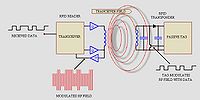RFID Systems
RFID is short for Radio Frequency Identification. Generally a RFID system consists of 2 parts. A Reader, and one or more Transponders, also known as Tags. RFID systems evolved from barcode labels as a means to automatically identify and track products and people.
Common Applications
Access Control
RFID Readers placed at entrances that require a person to pass their proximity card (RF tag) to be "read' before the access can be made.
Contactless Payment Systems
RFID tags used to carry payment information. RFIDs are particular suited to electronic Toll collection systems. Tags attached to vehicles, or carried by people transmit payment information to a fixed reader attached to a Toll station. Payments are then routinely deducted from a users account, or information is changed directly on the RFID tag.
Product Tracking and Inventory Control
RFID systems are commonly used to track and record the movement of ordinary items such as library books, clothes, factory pallets, electrical goods and numerous items.
Working Principles
In every RFID system the transponder Tags contain information. This information can be as little as a single binary bit , or be a large array of bits representing such things as an identity code, personal medical information, or literally any type of information that can be stored in digital binary format. Passive tags have no power source of their own and instead derive power from the incident electromagnetic field. Commonly the heart of each tag is a microchip. When the Tag enters the generated RF field it is able to draw enough power from the field to access its internal memory and transmit its stored information. When the transponder Tag draws power in this way the resultant interaction of the RF fields causes the voltage at the transceiver antenna to drop in value. This effect is utilized by the Tag to communicate its information to the reader. The Tag is able to control the amount of power drawn from the field and by doing so it can modulate the voltage sensed at the Transceiver according to the bit pattern it wishes to transmit.
Types of RFID Transponders
Passive Transponders
Passive Transponders have no internal power source. They draw their power from the electromagnetic field generated by the RFID reader. They have no active transmitter and rely on altering the RF field from the transceiver in a way that the reader can detect.
Active transponders
Active transponders have their own transmitters and power source, usually in the form of a small battery. As a result of this they are able to be detected at a greater range than Passive ones. Active Tags remain in a low power "idle" state until they detect the presence of the RF field being sent by the Reader. When the Tag leaves the area of the Reader it again powers down to its idle state to conserve its battery.
Semi-Passive Transponders
Semi-Passive Transponders have their own power source that powers the microchip only. They have no transmitter and as with Passive tags they rely on altering the RF field from the Transceiver to transmit their data.
Video
